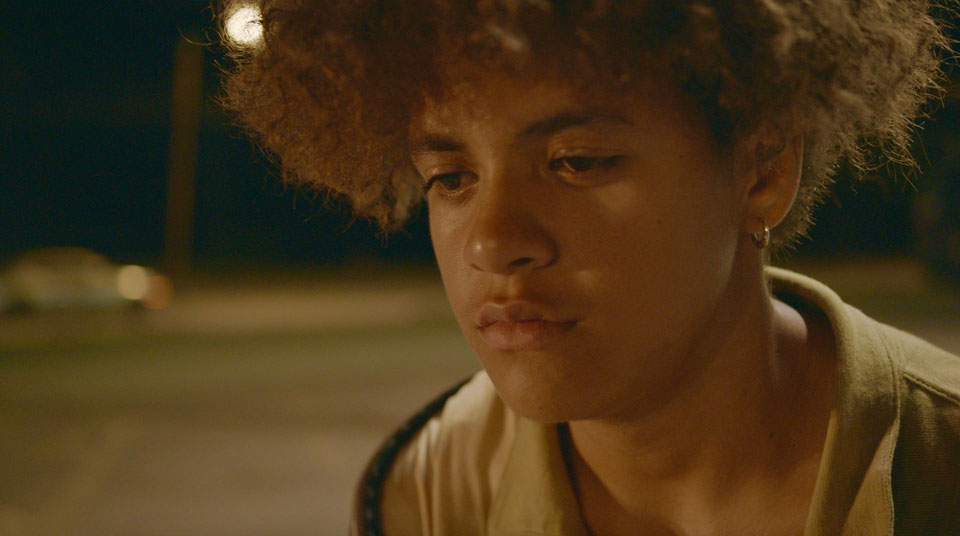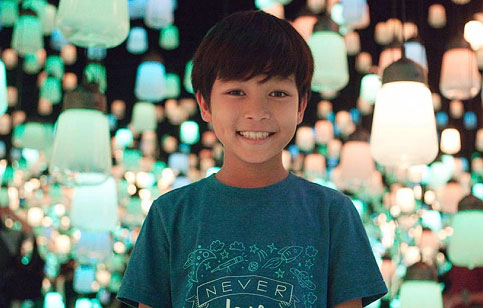
In what is likely my final report from this year’s Festival, here are more capsule reviews of short films from Hawaii being screened at the Los Angeles Asian Pacific Film Festival, which is taking place through Oct. 31. The topics include LGBTQ, homelessness, family, and prison.
Gimme shelter: Strangers in their own homeland
Writer/director Kimi Howl Lee’s earnest, absorbing Kama’aina, Child of the Land is one of the best Pacific Islander shorts presented at LAAPFF 2020. In it, the homeless Hawaiian teenager Mahina (portrayed by the excellent actress Malia Kamalani Soon) has to fend for herself on the Wai’anae Coast of Oahu, where a high percentage of Indigenous people live because of the presence there of Hawaiian Homelands, acres set aside for Natives. Having lived at Makaha on the Wai’anae side for about a decade, I loved seeing this up-close-and-personal location shooting on my old stomping grounds.
When we first encounter Mahina I didn’t realize this was a female character because of her—to use a conventional, patriarchal term—“boyish” appearance. But when she uses a public restroom we see her undergarment is bloody, which only adds to the complexity of Mahina’s situation as she tries to survive on her own in the wild.
What appears to be a Haole (Caucasian) do-gooder from Ohana Outreach (this seems to be an actual charitable organization) approaches Mahina and offers to help the bedraggled, obviously homeless adolescent. But red tape gets in the way, so the only thing the well-meaning white woman supplies Mahina with are pads for her period. This is the Festival’s second film which—along with the New Zealand Maori stellar short Hinekura—deals with the taboo topic of menstruation, and does so in a respectful, mature manner.
Although it isn’t dwelled upon, Kama’aina touches upon another “forbidden” subject: The 16-year-old Mahina identifies as gay. Although it is not specifically mentioned in the mini-drama, this could be the source of her ohana (family) problems and why she is outcast and living out-of-doors.
As many LGBTQ and trans women of color, in particular, are subjected to horrific atrocities, Kama’aina’s plot could go in dire directions. But in an interesting mixture of fact and fiction, Mahina finds refuge at Pu’uhonua o Wai’anae, a sort of real-life village for the homeless that’s largely inhabited by Hawaiians who have become a subjugated landless minority in their own ancestral homeland. The sanctuary is run by the kindly Aunty Twinkle, an actual Native organizer who accepts Mahina without passing judgment on her sexual identity, with the real Aunty playing herself.
This is not the first time Hawaiian leaders of Indigenous enclaves for the landless have appeared onscreen. In Cameron Crowe’s underrated, anti-militarization-of-outer-space 2015 feature Aloha, Sovereignty stalwart Bumpy Kanahele depicts himself. The independence advocate also appeared with the Hawaiian haven he leads in a Hawaii Five-O episode. By including actual Hawaiian personages (and their villages), these productions enhance their realism, especially Kama’aina’s.
The compassionate Aunty Twinkle and her village for the downtrodden also reminded me of the 1940 John Ford Depression-era masterpiece The Grapes of Wrath, wherein members of another oppressed minority, the “Okie” Joad family, finds rare respite from the hard times at a New Deal encampment for migrants administered by a benevolent caretaker (Grant Mitchell), representing the FDR administration.
With Kama’aina, Kimi Howl Lee, who has worked as a production assistant on TV series such as the Batman-themed Gotham, reveals herself to be a superb, sensitive storyteller, and I look forward to seeing full-length movies from her. Certainly, the 17-minute Kama’aina could easily be expanded into a feature-length motion picture. If there are any studios, producers, agents, et al, reading this, please give this wahine a camera and a budget! Likewise, actress Malia Kamalani Soon has a great future ahead of her as an artist if she pursues the creative path. And as for Aunty Twinkle, who acquits herself well portraying herself, she has a great future ahead of her too—as Governor of Hawaii! Kudos to the heartfelt, well-made Kama’aina!

Exquisite Indigenous animation in LGBTQ short
Hinaleimoana Wong-Kalu, Dean Hamer, and Joe Wilson’s exquisitely animated Kapaemahu has, like Kama’aina, an LGBTQ theme. The 8.5-minute cartoon dramatizes via animation a legend derived from Hawaiian mythology. The saga is set in ancient Hawaii as four voyagers from afar arrive in a sailing canoe (from where is not specified) at the shores of Waikiki, centuries before the visitor industry turned it into a high-rise hell. The quartet have healing powers and they proceed to cure those people of Oahu suffering from a variety of ailments.
The four are described as Polynesians who speak in deep voices but combine male characteristics with conventionally female traits. This “third gender” is called “mahus” in Hawaii, Tahiti and Samoa. When I was in my early twenties traveling throughout Oceania, I observed that mahus usually dressed in public in conventionally female garb and makeup and were overall accepted by the Polynesians, who were tolerant of this LGBTQ lifestyle, despite the missionary influence in the Islands.
As in Kama’aina, the foursome’s sexual identity is not accentuated in Kapaemahu nor is there any graphic nudity or depictions of sex acts. It is just part of the story that centers on the newcomers’ healing powers. This very beautiful, imaginatively crafted cartoon quickly traverses the centuries to reveal a rocky monument believed to have been built by the Islanders of antiquity to honor the healers, that has been unearthed and still exists in contemporary Waikiki. The animated artistry of Kapaemahu is a revelation and another step forward in the South Seas Cinema film genre, wherein Indigenous and local filmmakers are telling their own stories. Self-determination means the self determining itself and representations of it, not outsiders.
Haunted by loss
According to Mary Kawena Pukui’s authoritative Hawaiian Dictionary, the word mo’o refers to a “Lizard.” If I recall correctly, because of the creature’s reptilian tail, according to Pukui, mo’o also means “succession, series, especially a genealogical line, lineage.” Anela Ling’s 17-minute short Mo’o is more or less a ghost story set in contemporary Oahu, where it was filmed. Mika (Tysen Jao) is a moody boy who is sort of being watched over by the teenaged Kekoa (Sir Cornwell), who is somehow related to Mika. They party outdoors, go to Iolani Palace (although visually I wasn’t sure that this was actually the location where these scenes were lensed) as little Mika drinks beer.
What is really haunting them seems to be the death of a loved one. As Kekoa tells Mika, “It’s scary when someone’s gone.”
From here to paternity
Alika Maikau’s 8-minute short Moloka’i Bound is about a Hawaiian boy, Jonathan (Austin Tucker), waiting to be picked up after hours at his school at what appears to be Windward Oahu, and a young man, Kainoa (Holden Mandrial-Santos) who stops his pickup truck to keep the lad company. At first, it’s unclear who the youth behind the wheel with the dyed blonde hair is. Is Kainoa a child molester or what? Why is he so interested in this kid? When Jonathan refuses to get in his pickup truck for an offered ride home, the driver dismounts and joins the boy on the school’s steps, where he evinces some paternal concern for the lad.
When the boy’s mother Jessica (played by the gifted Danielle Zalopany, who is ubiquitous in this year’s LAAPFF) finally shows up, it turns out that Kainoa appears to be Jonathan’s absentee father, recently released from prison. He is trying to reestablish contact and a relationship with his son, which Jessica disapproves of. The film poses important questions about familial estrangement and if ex-convicts have the right to get on with their lives. Or must they be punished in perpetuity, forever paying for the error of their ways?
Unlike some of the other Pacific Islander shorts screened at LAAPFF such as the extremely satisfying Kama’aina that are self-contained, fully realized films, despite their brevity, Mo’o and Moloka’i Bound seem to be just fragments of a larger story. And as someone who has kayaked to and spent some time at Moloka’i—my favorite of the Hawaiian Islands—I am completely mystified as to why this short is called Moloka’i Bound. There must be a reason and I hope Malikau will get the opportunity some day to expand and complete this filmic fragment in time, especially if the talented Zalopany co-stars with the rest of the promising cast.
Many of the Pacific Islander shorts can be seen through Oct. 31 at LAAPFF’s Pacific Cinewaves pay-what-you-can link.










